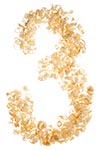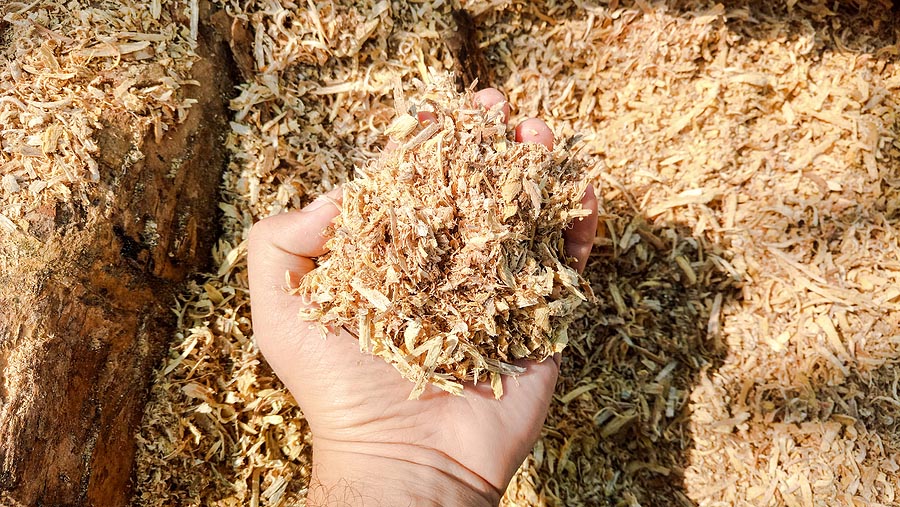Some of the best ways to improve our environmental impact are by using recycled products and choosing natural, biodegradable materials. Sawdust, made from recycled wood packaging and shipping pallets, neatly fits both of these descriptors, and has a surprising number of uses around the house, garden, and workshop. Most homes can benefit from at least a few of the many versatile uses of sawdust.
A property of sawdust that makes it especially useful for a variety of applications is its ability to absorb liquids. As a dry plant material with a high surface area, sawdust acts as a natural sponge, making it ideal for the following uses:

Oil, paint, grease, gasoline, and similar fluids are challenging to clean up using conventional methods when spilled. Fortunately, a sprinkle of sawdust makes an elegant solution to this difficult problem. Cover the spill in sawdust, let it absorb the liquid, and then sweep up the sawdust. Repeat as necessary until the spill is gone.

Cans of house paint or wood stain create difficulties after the job is completed and leftover product remains. It’s generally illegal to throw leftover paint in the trash due to its toxicity, meaning it also should never be poured down the sink or sewer. However, if you fill the can with sawdust and allow it to sit uncovered, the sawdust will absorb the moisture in the paint, causing it to solidify and harden. When this occurs, it is safe to throw away normally.

If there are areas of your yard where mud inevitably collects, resulting in muddy footprints tracked onto your kitchen floors, you can mitigate this problem by spreading sawdust in those problem puddle areas. The sawdust dries out the mud and prevents the problem at the source.
The particular texture of sawdust, with its combination of roughness and softness, creates a high level of friction, making it an excellent material for providing traction in slippery situations. This opens up another range of potential uses around the house and yard.

Rather than using rock salt or chemical de-icing agents, which can cause harm both to your yard in particular and the environment more broadly, spreading sawdust on your walkways can both absorb moisture that might otherwise ice over and turn into a hazard, and create necessary traction to help prevent dangerous slip and fall accidents.

If you keep a bag of sawdust in your car during the winter months, you have a readily available way to improve your tire traction against slippery conditions. This can be a real asset if you find yourself stuck in a slushy mess, or if you encounter another stuck vehicle in need of help.

In the warmer months of the year, you can enhance your property with paths and trails made of packed sawdust winding through your garden or woods. These paths help prevent soil erosion and deter weed growth, and if your property is steep or hilly, the sawdust provides surer footing on sloping ground.
Sawdust has a variety of other applications for the avid gardener, whether it’s helping plants to grow, or stopping things from growing where they shouldn’t.

Slugs and snails are reluctant to crawl across any material that is dry, scratchy, and dusty, including sawdust. Sawdust has the added advantage that it absorbs moisture from things it comes in contact with – which slugs do not enjoy. To maintain effectiveness, be sure to change or refresh the sawdust whenever it gets too wet.

Using sawdust mulch to block unwanted plant growth is fairly intuitive, but if you can source walnut sawdust, this wood contains natural herbicidal properties that make it particularly effective in preventing weed proliferation. Simply spread or pack the sawdust into whatever cracks or areas where weeds tend to grow.

Composting is an excellent way for gardeners to enrich their soil while disposing of certain types of kitchen and household waste in an ecologically responsible manner. Adding sawdust to your compost will add nutrients to your soil and aid in breaking down some of the other materials in your compost pile. Just make sure to give the sawdust at least a year to break down in the compost, because otherwise it can lower the nitrogen content of your soil. However, if your soil is too high in nitrogen, adding sawdust directly to it can help achieve the necessary nitrogen balance.
These ideas represent only a fraction of the possible uses for sawdust. The possibilities for sawdust are tremendously varied – it can be mixed into concrete for a more lightweight final product, or used as stuffing for sewing pincushions! Greenway Products & Services is here to satisfy any of your sawdust needs; contact us with any questions you may have, and for a quote.




Leave A Comment